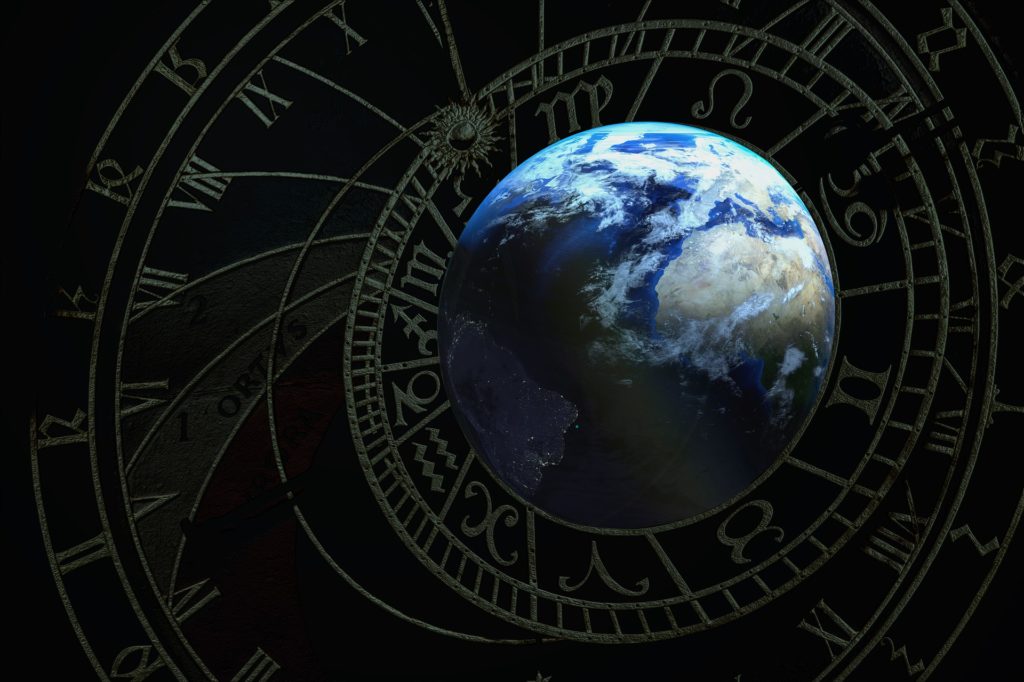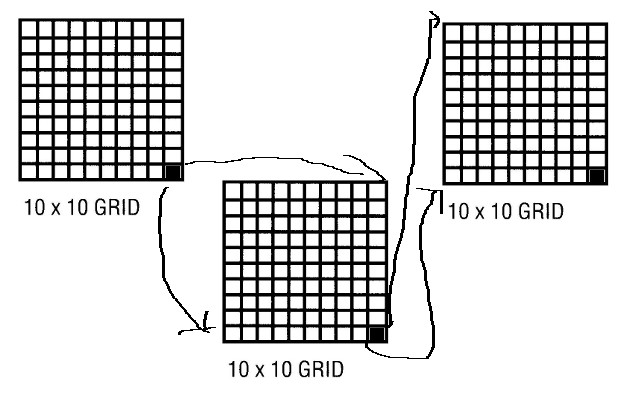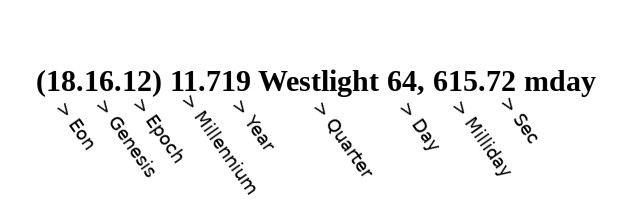(18.16.12) 11.719 Westquarter 63 EE
Soundtrack in my head: Chemical Brothers, “Let Forever Be”

I have a geek fascination with calendars and I cannot lie. Many people have made many attempts at calendar reform over the years. I decided to put forward my own modest proposal for calendar reform, to bring it it into the 21st Century. (Well really, it’s Century 117, but more on that later). Why? Well, why not? It’s interesting to me. And I think I can make a solid case for what I’ve come up with.
When I considered myself a Baha’i, I was fascinated by the Baha’i Calendar, with its nineteen months of nineteen days each. Though using it was, well, kind of awkward. A few years after I left the Baha’i Faith, I began to toy with the idea of inventing my own calendar, and I played with a number of concepts.
An outdated calendar
If you think this is strange, let me point out something that’s stranger. With all of the changes in our world, and all the knowledge we’ve gained, the calendar we use has undergone little change since Julius Caesar. Really. The only change after Caesar was introduced 1582 CE by Pope Gregory XIII. This reform simply subtracted three leap years from every 400 year cycle.
Then, as is true now, few calendars went back further in time than 6,000 years, and most scholars in the 16th century considered that time to be roughly the beginning of the world. Now we know that it is roughly 4.5 billion years old. I would argue that sticking to an older calendar creates a horribly skewed view of our planet. In reality, the Hebrew and Chinese calendars, which are among the oldest calendars, cover a period roughly one-one millionth of the actual history of Planet Earth. No wonder we are destroying this planet. That’s one argument for calendar reform right there.
Another reason for reform: We human beings have a hard time conceiving of a million or billion years. Breakdowns of Earth history like these are helpful, but still a bit overwhelming. So I break down the calendar into units of one hundred as often as possible. We can easily visualize one hundred as a ten-by-ten grid, and then one of the blocks themselves can become a ten-by-ten grid, as I try to crudely illustrate below:.

The date expression looks like this:

The Epic Time Scales
The Earth Epic Calendar divides the expression of the date and time into three sections. The first three numbers in parentheses are called the Epic Time Scales, and consist of units that are 250 million years, 2.5 million years, and 25,000 years respectively. These may seem strange numbers, but they are loaded with significance. The length of an Eon (250 million years) happens to correspond roughly with when the first dinosaurs appeared on Earth. It also corresponds more or less with a galactic year, or the time it takes for the Sun to orbit the Milky Way Galaxy. Two Eons ago puts us nearly the beginning of the Cambrian Explosion. And given that we are in Eon 18 since the creation of the Earth, 8/9ths of the planet’s history predates most of the complex life forms we are used to seeing today. The Earth was created 4.54 billion years ago with a margin of error of about 50 million years in either direction, or 1%.
Continuing with the Epic Time Scales, one Genesis (2.5 million years) ago is roughly when the genus Homo first appeared. (Actually, the line between Australopithecus and Homo is widely debated, so it’s really a rough estimate.) Note that this period of time is about one hundred times shorter than when the dinosaurs first appeared. Note, too, that the margin of error is plus or minus 50 million years, which is equivalent to plus or minus 20 Geneses or a range of 40 Geneses total. This margin of error of the date of Earth’s creation is itself 40 times the period of time of the advent of Homo and the present. How’s that for calendar reform so far? Do we feel small yet?
Going on to the next unit of time, the Epoch, has a length of 25,000 years. It is roughly equal to the Axial Precession. Such a precession, which varies in length, is responsible for the rotation of the night sky. The Greeks were able to discover this even though they thought the Earth was the center of the universe at the time. (At least they knew it was a sphere.) It’s this phenomenon that has many astrologers talking about the transition from the Age of Pisces to the Age of Aquarius—a full axial precession is one that goes through all twelve signs of the zodiac. The axial precession also changes which star represents our North Star and changes the lengths of Earth’s seasons relative to each other (currently Summer and Spring in the Northern Hemisphere are the longest).
The first Epoch of Genesis 16 (the calendar date, not the Bible chapter, mind you) is dated 300,000 years ago, roughly when Homo Sapiens first appeared. Thus, we know that Homo Sapiens has existed for roughly one-eighth of the time that the genus Homo has walked the Earth. The current Epoch is dated from 9701 B.C., or about 11,720 years ago. This is the date of the beginning of the Holocene set ten years ago by the International Commission on Stratigraphy. This organization also defines the dates of the other geological eras, epochs, and ages. The beginning of the Holocene marks the end of the last glacial period (what most people refer to as the Ice Age), and a point after which development of human civilizations made great leaps and bounds.
See how much we learn about ourselves from just three or four numbers on a calendar? Is this calendar reform or what?
The rest of the calendar
I won’t go into as much painstaking detail of remaining six numbers on the calendar. The Earth Epic Calendar website I created does that for you. We all know how long a year and a millennium are. Instead of months, I divide the year into quarters of 91-92 days each (kind of in keeping of the “rule of 100s” I created). This way, we can plan up to thirteen weeks in advance without having to flip the calendar page. The year begins on the midnight UTC closest to the Winter Solstice in the Northern Hemisphere, or roughly eleven days before the New Year that much of the rest of the world celebrates.
This makes the Earth Epic Calendar an observation-based calendar like the Solar Hijri calendar which serves as the official calendar in Iran and Afghanistan, whose new year or Now Ruz begins at the Spring Equinox in the Northern Hemisphere. The length of the year is then determined by the number of days between these astronomical phenomena—usually 365, but sometimes 366 days. The leap years are usually every four years, but sometimes every five instead. The Solar Hijri calendar is currently the most accurate in the world, and NOT the Gregorian as Euro-centrists would like to believe.
Continuing beyond the day on the calendar, the third set of number relate to the time of day. One milliday, or one-thousandth of a day, is one minute and 26.4 seconds, and the “sec”, which is one-hundredth of a milliday, or 0.86 seconds. This decimal time or metric time has been used in the past in China, and was attempted during the French Revolution. In an interesting chapter of Internet history, decimal time was even promoted as Swatch Internet Time in 1998 by the Swatch corporation. Except that they expected everybody to use the UTC +1 time zone in Switzerland because it was going to be the time zone of Nation.1, an anarchist concept of a global Internet Nation populated by and run by children. Yup, you heard that right.
In conclusion, I have absolutely no idea to what extent this calendar reform idea is going to catch on, nor do I have any attachment thereof. (However, I do have a Creative Commons copyright on this calendar that requires proper attribution.) It’s essentially a nerd labor of love that took on a life of its own, and became something I wouldn’t have even imagined. It looks like 31 people downloaded a copy of this labor of love in the past year or so, and I just put up the 11.720 calendar.
We’ll see what comes of it. You can download your own copy of the new Earth Epic Calendar here.
Somehow, the video below by The Chemical Brothers and directed by Michel Gondry seems to provide a nice parallel to this article–even though the Earth Epic Calendar is not meant to be anywhere near as disorienting as this video.

One thought on “my calendar reform effort: the Earth Epic Calendar”